Mapping the Distribution and Discharge of Plastic Pollution in the Ganga River
Abstract
1. Introduction
2. Study Area
3. Methods
3.1. Site Selection
3.2. Data Collection
3.3. Data Analysis
4. Results
4.1. River Shorelines and Floodplains
4.2. Rural vs. Urban
4.3. Correlation Between Urbanisation and Plastic-Packaged Product Availability in the Ganga River Basin Using Geospatial Technology
4.4. Variations Depend on Population Density
4.5. Seasonal Variations
4.6. Debris Distribution in High Biodiversity Zone
4.7. Ghost Fishing Gears
5. Discussion
Conclusions and Recommendations
- Urgency (based on the impact on climate/freshwater ecosystems and practical feasibility):
- ○
- 1—High priority: immediate action is critical to avoid severe ecological damage and to leverage existing feasibility.
- ○
- 2—Moderate priority: important for long-term ecosystem health, may require incremental policy changes or stakeholder alignment.
- ○
- 3—Low priority: less immediate ecological threat, or substantial feasibility constraints.
- Timescale (based on financial requirements and time needed for implementation):
- ○
- A—Short term (1–2 years): lower financial outlay; can be implemented relatively quickly.
- ○
- B—Medium term (3–5 years): moderate to significant financial investment; requires phased planning and stakeholder coordination.
- ○
- C—Long term (5+ years): high capital investment and/or major policy integration needed.
Supplementary Materials
Author Contributions
Funding
Institutional Review Board Statement
Informed Consent Statement
Data Availability Statement
Acknowledgments
Conflicts of Interest
References
- Bodor, A.; Feigl, G.; Kolossa, B.; Mészáros, E.; Laczi, K.; Kovács, E.; Perei, K.; Rákhely, G. Soils in distress: The impacts and ecological risks of (micro) plastic pollution in the terrestrial environment. Ecotoxicol. Environ. Saf. 2024, 269, 115807. [Google Scholar] [CrossRef] [PubMed]
- Free, C.M.; Jensen, O.P.; Mason, S.A.; Eriksen, M.; Williamson, N.J.; Boldgiv, B. High-levels of microplastic pollution in a large, remote, mountain lake. Mar. Pollut. Bull. 2014, 85, 156–163. [Google Scholar] [CrossRef]
- Geyer, R.; Jambeck, J.R.; Law, K.L. Production, use, and fate of all plastics ever made. Sci. Adv. 2017, 3, e1700782. [Google Scholar] [CrossRef] [PubMed]
- Obbard, R.W.; Sadri, S.; Wong, Y.Q.; Khitun, A.A.; Baker, I.; Thompson, R.C. Global warming releases microplastic legacy frozen in Arctic Sea ice. Earth’s Future 2014, 2, 315–320. [Google Scholar] [CrossRef]
- Waller, C.L.; Griffiths, H.J.; Waluda, C.M.; Thorpe, S.E.; Loaiza, I.; Moreno, B.; Pacherres, C.O.; Hughes, K.A. Microplastics in the Antarctic marine system: An emerging area of research. Sci. Total Environ. 2017, 598, 220–227. [Google Scholar] [CrossRef]
- Carpenter, E.J.; Smith, K.L., Jr. Plastics on the Sargasso Sea surface. Science 1972, 175, 1240–1241. [Google Scholar] [CrossRef] [PubMed]
- Goldstein, M.C.; Rosenberg, M.; Cheng, L. Increased oceanic microplastic debris enhances oviposition in an endemic pelagic insect. Biol. Lett. 2012, 8, 817–820. [Google Scholar] [CrossRef]
- Law, K.L.; Morét-Ferguson, S.; Maximenko, N.A.; Proskurowski, G.; Peacock, E.E.; Hafner, J.; Reddy, C.M. Plastic accumulation in the North Atlantic subtropical gyre. Science 2010, 329, 1185–1188. [Google Scholar] [CrossRef]
- Lebreton, L.; Slat, B.; Ferrari, F.; Sainte-Rose, B.; Aitken, J.; Marthouse, R.; Hajbane, S.; Cunsolo, S.; Schwarz, A.; Levivier, A.; et al. Evidence that the Great Pacific Garbage Patch is rapidly accumulating plastic. Sci. Rep. 2018, 8, 4666. [Google Scholar] [CrossRef]
- Thompson, R.C.; Olsen, Y.; Mitchell, R.P.; Davis, A.; Rowland, S.J.; John, A.W.; McGonigle, D.; Russell, A.E. Lost at sea: Where is all the plastic? Science 2004, 304, 838. [Google Scholar] [CrossRef]
- Blettler, M.C.M.; Garello, N.; Ginon, L.; Abrial, E.; Espinola, L.A.; Wantzen, K.M. Massive plastic pollution in a mega-river of a developing country: Sediment deposition and ingestion by fish (Prochilodus lineatus). Environ. Pollut. 2019, 255, 113348. [Google Scholar] [CrossRef]
- Blettler, M.C.; Abrial, E.; Khan, F.R.; Sivri, N.; Espinola, L.A. Freshwater plastic pollution: Recognizing research biases and identifying knowledge gaps. Water Res. 2018, 143, 416–424. [Google Scholar] [CrossRef]
- Lebreton, L.C.M.; Van Der Zwet, J.; Damsteeg, J.W.; Slat, B.; Andrady, A.; Reisser, J. River plastic emissions to the world’s oceans. Nat. Commun. 2017, 8, 15611. [Google Scholar] [CrossRef] [PubMed]
- Owens, K.A.; Kamil, P.I. Adapting Coastal Collection Methods for River Assessment to Increase Data on Global Plastic Pollution: Examples from India and Indonesia. Front. Environ. Sci. 2020, 7, 208. [Google Scholar] [CrossRef]
- Schmidt, C.; Krauth, T.; Wagner, S. Export of Plastic Debris by Rivers into the Sea. Environ. Sci. Technol. 2017, 51, 12246–12253. [Google Scholar] [CrossRef] [PubMed]
- Cole, M.; Lindeque, P.; Halsband, C.; Galloway, T.S. Microplastics as contaminants in the marine environment: A review. Mar. Pollut. Bull. 2011, 62, 2588–2597. [Google Scholar] [CrossRef]
- Azevedo-Santos, V.M.; Brito, M.F.; Manoel, P.S.; Perroca, J.F.; Rodrigues-Filho, J.L.; Paschoal, L.R.; Gonçalves, G.R.L.; Wolf, M.R.; Blettler, M.C.M.; Andrade, M.C.; et al. Plastic pollution: A focus on freshwater biodiversity. Ambio 2021, 50, 1313–1324. [Google Scholar] [CrossRef]
- Lestari, P.; Trihadiningrum, Y. The impact of improper solid waste management to plastic pollution in Indonesian coast and marine environment. Mar. Pollut. Bull. 2019, 149, 110505. [Google Scholar] [CrossRef]
- Nelms, S.E.; Duncan, E.M.; Patel, S.; Badola, R.; Bhola, S.; Chakma, S.; Chowdhury, G.W.; Godley, B.J.; Haque, A.B.; Johnson, J.A.; et al. Riverine plastic pollution from fisheries: Insights from the Ganges River system. Sci. Total Environ. 2021, 756, 143305. [Google Scholar] [CrossRef]
- Rochman, C.M.; Tahir, A.; Williams, S.L.; Baxa, D.V.; Lam, R.; Miller, J.T.; Teh, F.-C.; Werorilangi, S.; Teh, S.J. Anthropogenic debris in seafood: Plastic debris and fibers from textiles in fish and bivalves sold for human consumption. Sci. Rep. 2015, 5, 14340. [Google Scholar] [CrossRef]
- Roman, L.; Schuyler, Q.; Wilcox, C.; Hardesty, B.D. Plastic pollution is killing marine megafauna, but how do we prioritize policies to reduce mortality? Conserv. Lett. 2021, 14, e12781. [Google Scholar] [CrossRef]
- Wright, S.L.; Kelly, F.J. Threat to human health from environmental plastics. BMJ 2017, 358, j4334. [Google Scholar] [CrossRef] [PubMed]
- Hubacek, K.; Guan, D.; Barua, A. Changing lifestyles and consumption patterns in developing countries: A scenario analysis for China and India. Futures 2007, 39, 1084–1096. [Google Scholar] [CrossRef]
- Jambeck, J.R.; Geyer, R.; Wilcox, C.; Siegler, T.R.; Perryman, M.; Andrady, A.; Narayan, R.; Law, K.L. Plastic waste inputs from land into the ocean. Science 2015, 347, 768–771. [Google Scholar] [CrossRef]
- Rafey, A.; Siddiqui, F.Z. A review of plastic waste management in India—Challenges and opportunities. Int. J. Environ. Anal. Chem. 2023, 103, 3971–3987. [Google Scholar] [CrossRef]
- Chandramouli, C.; General, R. Census of India 2011; Provisional Population Totals; Government of India: New Delhi, India, 2021; pp. 409–413. [Google Scholar]
- Apostol, L.; Mihai, F.C. Rural waste management: Challenges and issues in Romania. Present Environ. Sustain. Dev. 2012, 105–114. [Google Scholar] [CrossRef]
- Khan, F.R.; Mayoma, B.S.; Biginagwa, F.J.; Syberg, K. Microplastics in inland African waters: Presence, sources, and fate. In Freshwater Microplastics: Emerging Environmental Contaminants? Springer Nature: London, UK, 2018; pp. 101–124. [Google Scholar]
- Mihai, F.C.; Gündoğdu, S.; Markley, L.A.; Olivelli, A.; Khan, F.R.; Gwinnett, C.; Gutberlet, J.; Reyna-Bensusan, N.; Llanquileo-Melgarejo, P.; Meidiana, C.; et al. Plastic pollution, waste management issues, and circular economy opportunities in rural communities. Sustainability 2021, 14, 20. [Google Scholar] [CrossRef]
- Nxumalo, S.M.; Mabaso, S.D.; Mamba, S.F.; Singwane, S.S. Plastic waste management practices in the rural areas of Eswatini. Soc. Sci. Humanit. Open 2020, 2, 100066. [Google Scholar] [CrossRef]
- Gasperi, J.; Dris, R.; Bonin, T.; Rocher, V.; Tassin, B. Assessment of floating plastic debris in surface water along the Seine River. Environ. Pollut. 2014, 195, 163–166. [Google Scholar] [CrossRef]
- Hurley, R.R.; Woodward, J.C.; Rothwell, J.J. Ingestion of microplastics by freshwater tubifex worms. Environ. Sci. Technol. 2017, 51, 12844–12851. [Google Scholar] [CrossRef]
- Sinha, R.; Mohanta, H.; Jain, V.; Tandon, S.K. Geomorphic diversity as a river management tool and its application to the Ganga River, India. River Res. Appl. 2017, 33, 1156–1176. [Google Scholar] [CrossRef]
- Kaza, S.; Yao, L.; Bhada-Tata, P.; Van Woerden, F. What a WASTE 2.0: A global Snapshot of Solid Waste Management to 2050; World Bank Publications: Washington, DC, USA, 2018. [Google Scholar]
- Schneider, F.; Parsons, S.; Clift, S.; Stolte, A.; McManus, M.C. Collected marine litter—A growing waste challenge. Mar. Pollut. Bull. 2018, 128, 162–174. [Google Scholar] [CrossRef]
- Sanghi, R.; Kaushal, N. Introduction to our national river Ganga via cmaps. In Our National River Ganga: Lifeline of Millions; Springer Nature: London, UK, 2014; pp. 3–44. [Google Scholar]
- Nomani, M.Z.M.; Salahuddin, G.H.A.Z.A.L. River health assessment of Ganga basin in India: A comparative perspective. Pollut. Res. 2020, 39, S266–S271. [Google Scholar]
- Shukla, A.K.; Ojha, C.S.P.; Garg, R.D.; Shukla, S.; Pal, L. Influence of spatial urbanization on hydrological components of the Upper Ganga River Basin, India. J. Hazard. Toxic Radioact. Waste 2020, 24, 04020028. [Google Scholar] [CrossRef]
- Das, G.C.; Sharma, S.P.; Ali, S.Z.; Gawan, S.; Usmani, A.A.; Sarkar, A.; Katdare, S.; Rawat, A.; Gangaimaran, P.; Panda, A.K.; et al. Prioritising river stretches using multi-modelling habitat suitability of Gangetic dolphin (Platanista gangetica) as a flagship species for aquatic biodiversity conservation in the Ganga River Basin, India. Ecol. Indic. 2022, 145, 109680. [Google Scholar] [CrossRef]
- WII-NMCG. Biodiversity Profile of the River: Planning Aquatic Species Restoration for Ganga River; Wildlife Institute of India: Dehradun, India, 2019; p. 223.
- Esri. ArcGIS, Version 10.6.1; Computer Software. 2020. Available online: https://www.esri.com/ (accessed on 26 October 2023).
- Office of the Registrar General Census Commissioner, India. Census of India 2001; Ministry of Home Affairs, Government of India: New Delhi, India, 2001. Available online: http://censusindia.gov.in/ (accessed on 30 October 2023).
- Wildlife Institute of India (WII) ENVIS Centre. Protected Area Network in India. 2022. Available online: https://wiienvis.nic.in/Database/Protected_Area_854.aspx (accessed on 24 February 2025).
- Kumar, R.; Sharma, P.; Manna, C.; Jain, M. Abundance, interaction, ingestion, ecological concerns, and mitigation policies of microplastic pollution in riverine ecosystem: A review. Sci. Total Environ. 2021, 782, 146695. [Google Scholar] [CrossRef]
- Opfer, S.; Arthur, C.; Lippiatt, S. NOAA Marine Debris Shoreline Survey Field Guide; NOAA Marine Debris Program: Silver Spring, MD, USA, 2012.
- ESRI. ArcGIS Desktop: Release 10; Environmental Systems Research Institute: Redlands, CA, USA, 2011. [Google Scholar]
- Rehman, S.; Honap, V.; Siddiqui, A.; Maske, A.; Maithani, S. Spatio-Temporal Variations in Night Lights, Economy and Night Light Emissions in States of India. J. Indian Soc. Remote Sens. 2021, 49, 2933–2943. [Google Scholar] [CrossRef]
- Ye, Y.; Yun, G.; He, Y.; Lin, R.; He, T.; Qian, Z. Spatiotemporal Characteristics of Urbanization in the Taiwan Strait Based on Nighttime Light Data from 1992 to 2020. Remote Sens. 2023, 15, 3226. [Google Scholar] [CrossRef]
- Bedi, T.K.; Puntambekar, K.; Singh, S. Assessment of Light Pollution in Indian Scenario: A Case of Bangalore. J. Inst. Eng. Ser. A 2021, 102, 657–672. [Google Scholar] [CrossRef]
- Youngblood, K.; Brooks, A.; Das, N.; Singh, A.; Sultana, M.; Verma, G.; Zakir, T.; Chowdhury, G.W.; Duncan, E.; Khatoon, H.; et al. Rapid characterisation of macroplastic input and leakage in the Ganges river basin. Environ. Sci. Technol. 2022, 56, 4029–4038. [Google Scholar] [CrossRef]
- Marais, M.; Armitage, N.; Wise, C. The measurement and reduction of urban litter entering stormwater drainage systems: Paper 1-Quantifying the problem using the City of Cape Town as a case study. Water Sa 2004, 30, 469–482. [Google Scholar] [CrossRef][Green Version]
- Seto, K.C.; Fragkias, M.; Güneralp, B.; Reilly, M.K. A meta-analysis of global urban land expansion. PLoS ONE 2011, 6, e23777. [Google Scholar] [CrossRef]
- Van Emmerik, T.H.; Frings, R.M.; Schreyers, L.J.; Hauk, R.; de Lange, S.I.; Mellink, Y.A. River plastic transport and deposition amplified by extreme flood. Nat. Water 2023, 1, 514–522. [Google Scholar] [CrossRef]
- Meijer, L.J.; Van Emmerik, T.; Van Der Ent, R.; Schmidt, C.; Lebreton, L. More than 1000 rivers account for 80% of global riverine plastic emissions into the ocean. Sci. Adv. 2021, 7, eaaz5803. [Google Scholar] [CrossRef]
- Roebroek, C.T.; Harrigan, S.; Van Emmerik, T.H.; Baugh, C.; Eilander, D.; Prudhomme, C.; Pappenberger, F. Plastic in global rivers: Are floods making it worse? Environ. Res. Lett. 2021, 16, 025003. [Google Scholar] [CrossRef]
- Van Emmerik, T.H. The impact of floods on plastic pollution. Glob. Sustain. 2024, 7, e17. [Google Scholar] [CrossRef]
- Van Emmerik, T.; Schwarz, A. Plastic debris in rivers. Wiley Interdiscip. Rev. Water 2020, 7, e1398. [Google Scholar] [CrossRef]
- Tariq, A.; Qadir, A.; Ahmad, S.R. Consequences of plastic trash on behavior and ecology of birds. In Microplastic Pollution: Environmental Occurrence and Treatment Technologies; Springer International Publishing: Cham, Switzerland, 2022; pp. 347–368. [Google Scholar]
- Barrett, N.; Miller, J.; Orbock-Miller, S. Quantification and Categorization of Macroplastics (Plastic Debris) within a Headwaters Basin in Western North Carolina, USA: Implications to the Potential Impacts of Plastic Pollution on Biota. Environments 2024, 11, 195. [Google Scholar] [CrossRef]
- Bellasi, A.; Binda, G.; Pozzi, A.; Galafassi, S.; Volta, P.; Bettinetti, R. Microplastic contamination in freshwater environments: A review, focusing on interactions with sediments and benthic organisms. Environments 2020, 7, 30. [Google Scholar] [CrossRef]
- Almeida, M.P.D.; Gaylarde, C.; Pompermayer, F.C.; Lima, L.D.S.; Delgado, J.D.F.; Scott, D.; Neves, C.V.; Vieira, K.S.; Neto, J.A.B.; Fonseca, E.M. The complex dynamics of microplastic migration through different aquatic environments: Subsidies for a better understanding of its environmental dispersion. Microplastics 2023, 2, 62–77. [Google Scholar] [CrossRef]
- Gutiérrez-Rial, D.; Villar, I.; Álvarez-Troncoso, R.; Soto, B.; Mato, S.; Garrido, J. Assessment of Microplastic Pollution in River Ecosystems: Effect of Land Use and Biotic Indices. Water 2024, 16, 1369. [Google Scholar] [CrossRef]
- Richardson, K.; Asmutis-Silvia, R.; Drinkwin, J.; Gilardi, K.V.; Giskes, I.; Jones, G.; O’Brien, K.; Pragnell-Raasch, H.; Ludwig, L.; Antonelis, K.; et al. Building evidence around ghost gear: Global trends and analysis for sustainable solutions at scale. Mar. Pollut. Bull. 2019, 138, 222–229. [Google Scholar] [CrossRef] [PubMed]
- Badola, S.; Gill, A.K.; Dobriyal, P.; Patel, S.; Khan, M.Z.; Hussain, S.A. Haunting the Ganges: Addressing the issues of ghost gear in the Ganga River through an incentive-based institutional mechanism. Front. Conserv. Sci. 2024, 5, 1341434. [Google Scholar] [CrossRef]
- Do, H.L.; Armstrong, C.W. Ghost fishing gear and their effect on ecosystem services–Identification and knowledge gaps. Mar. Policy 2023, 150, 105528. [Google Scholar] [CrossRef]
- MoEFCC. ‘Ban on Single-Use Plastic’ Starred Question No. 173; Ministry of Environment, Forest and Climate Change: New Delhi, India; Government of India: New Delhi, India, 2021.
- Nøklebye, E.; Adam, H.N.; Roy-Basu, A.; Bharat, G.K.; Steindal, E.H. Plastic bans in India—Addressing the socio-economic and environmental complexities. Environ. Sci. Policy 2023, 139, 219–227. [Google Scholar] [CrossRef]
- Lindhqvist, T. Extended Producer Responsibility in Cleaner Production: Policy Principle to Promote Environmental Improvements of Product Systems. Ph.D. Thesis, Lund University, Lund, Sweden, 2000. [Google Scholar]
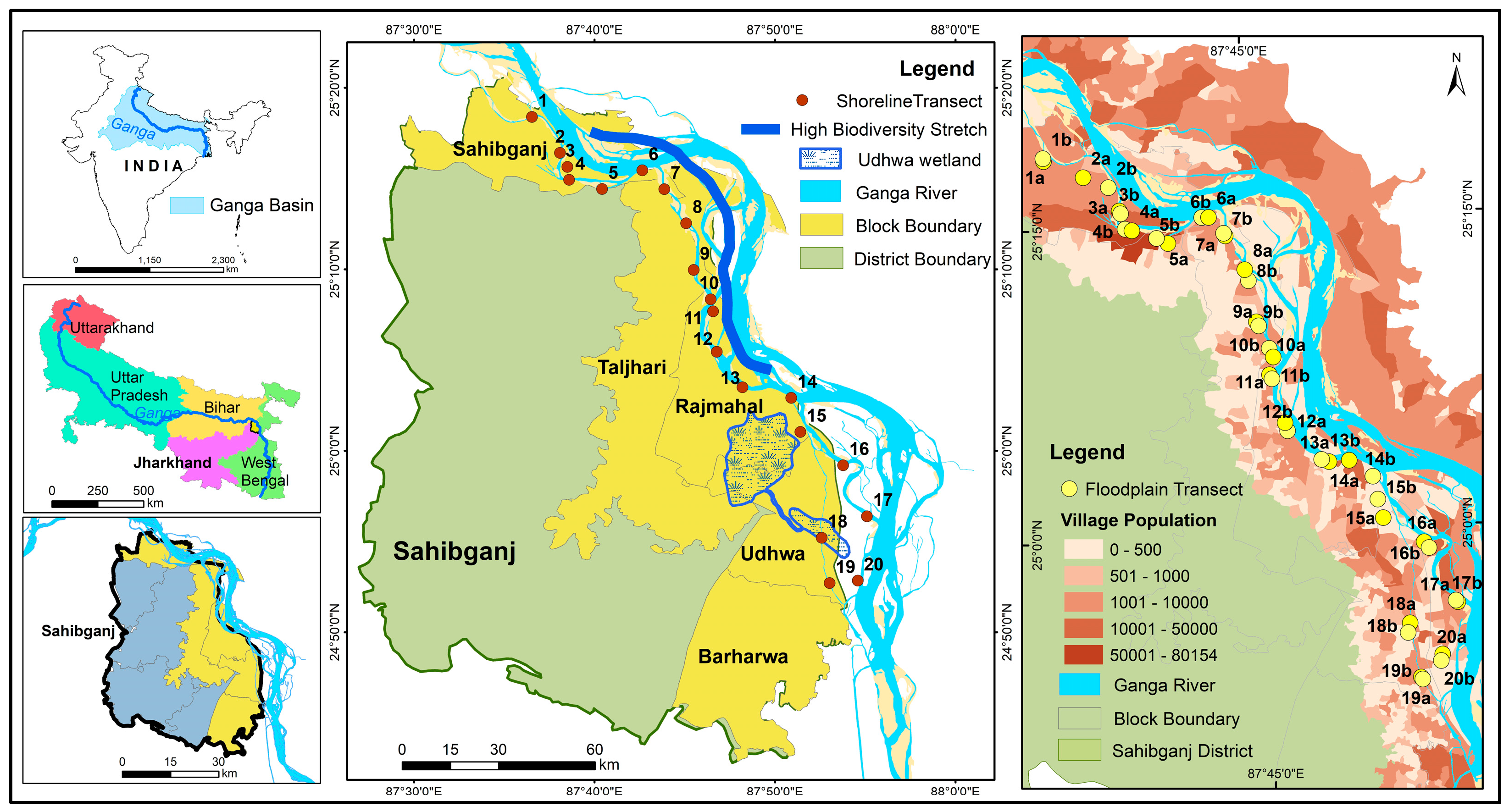
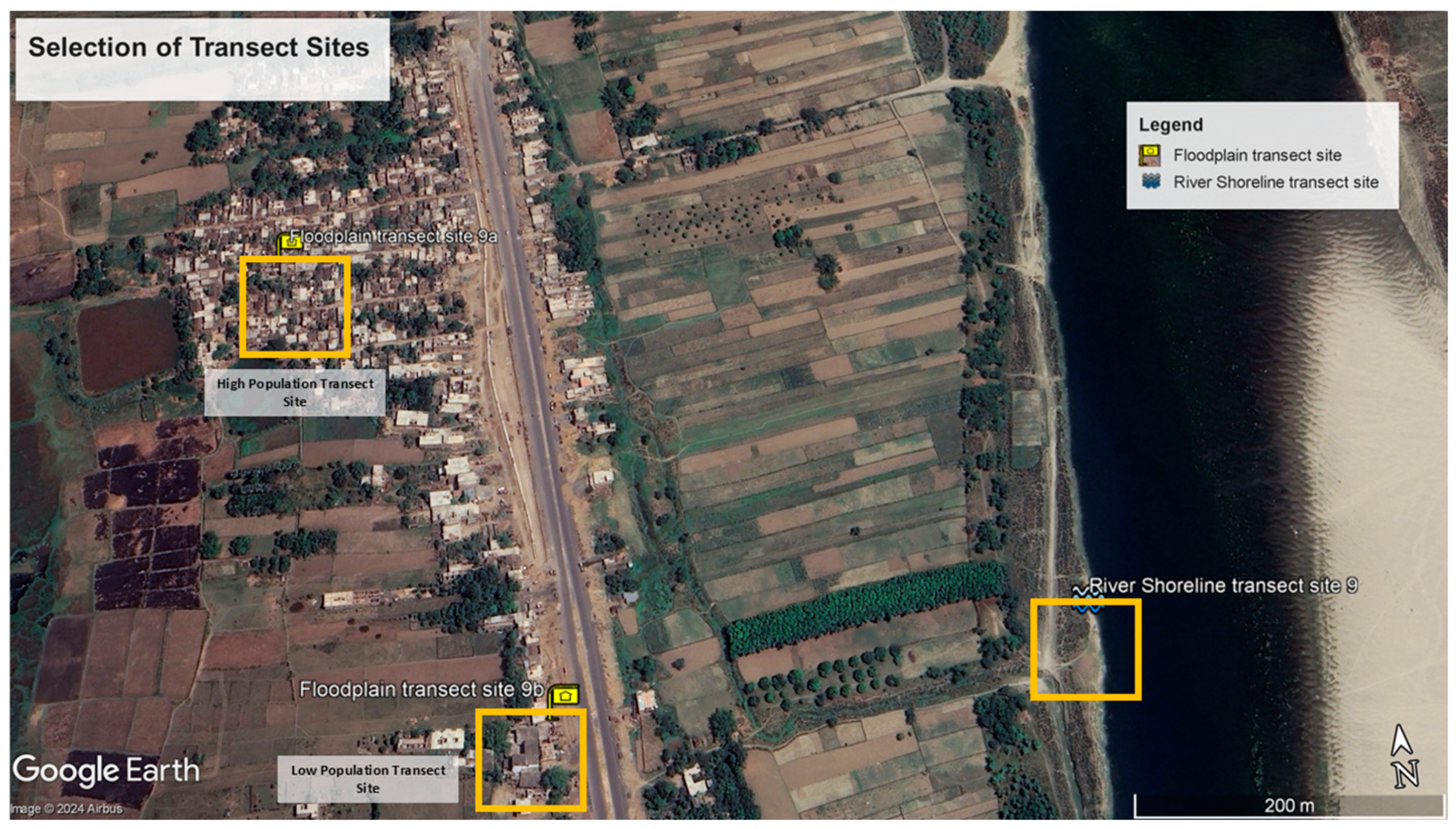
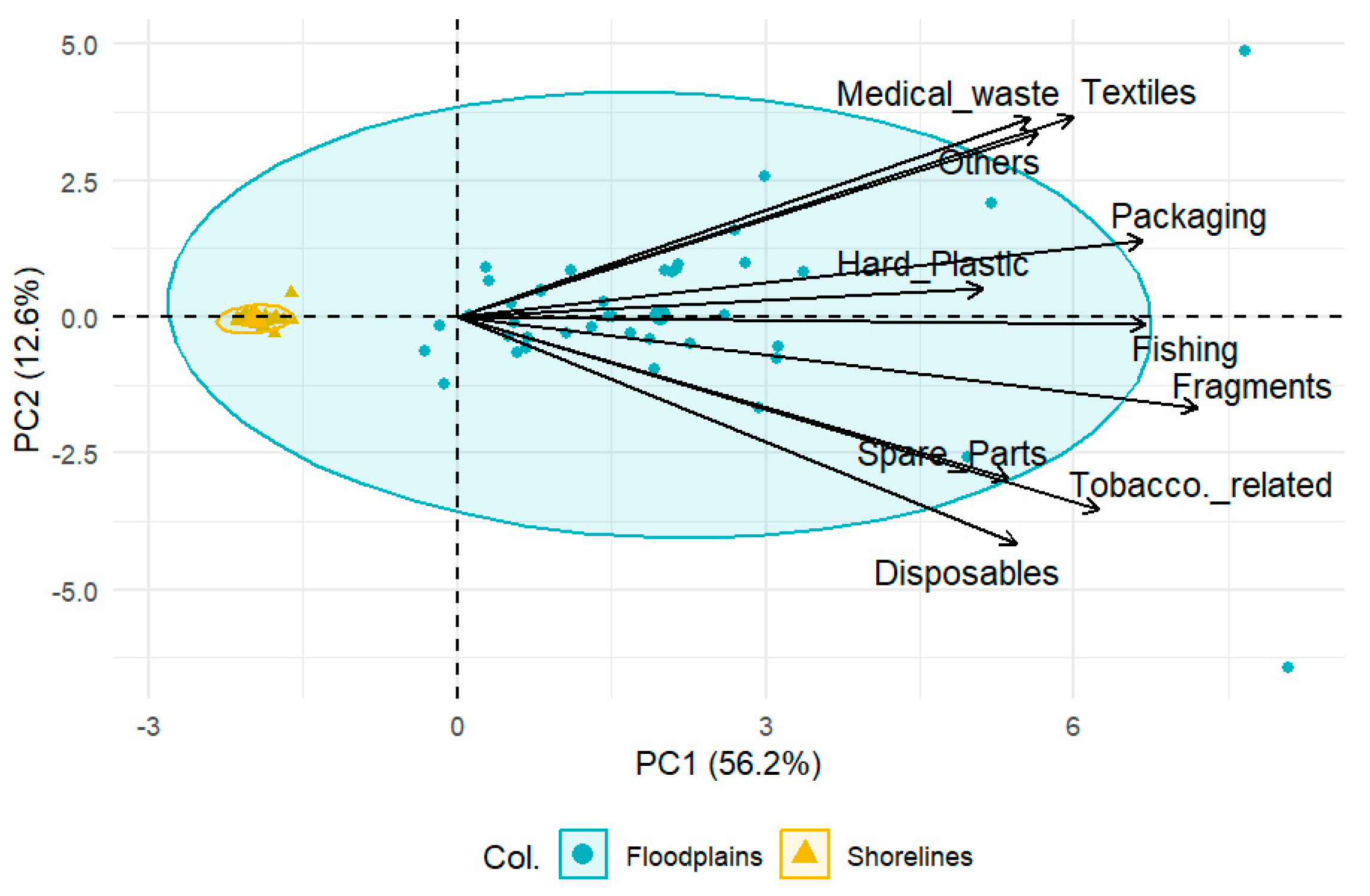
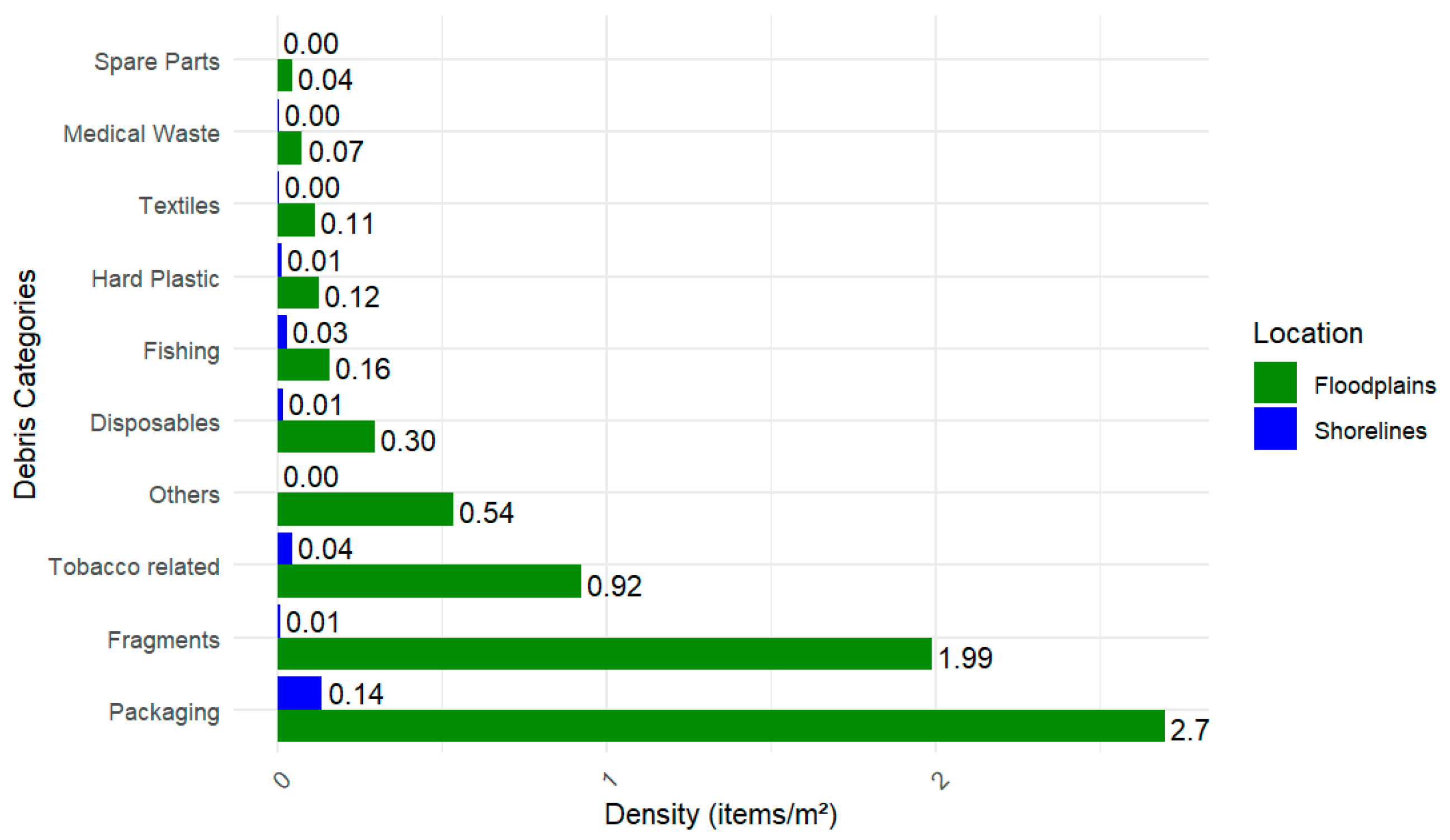
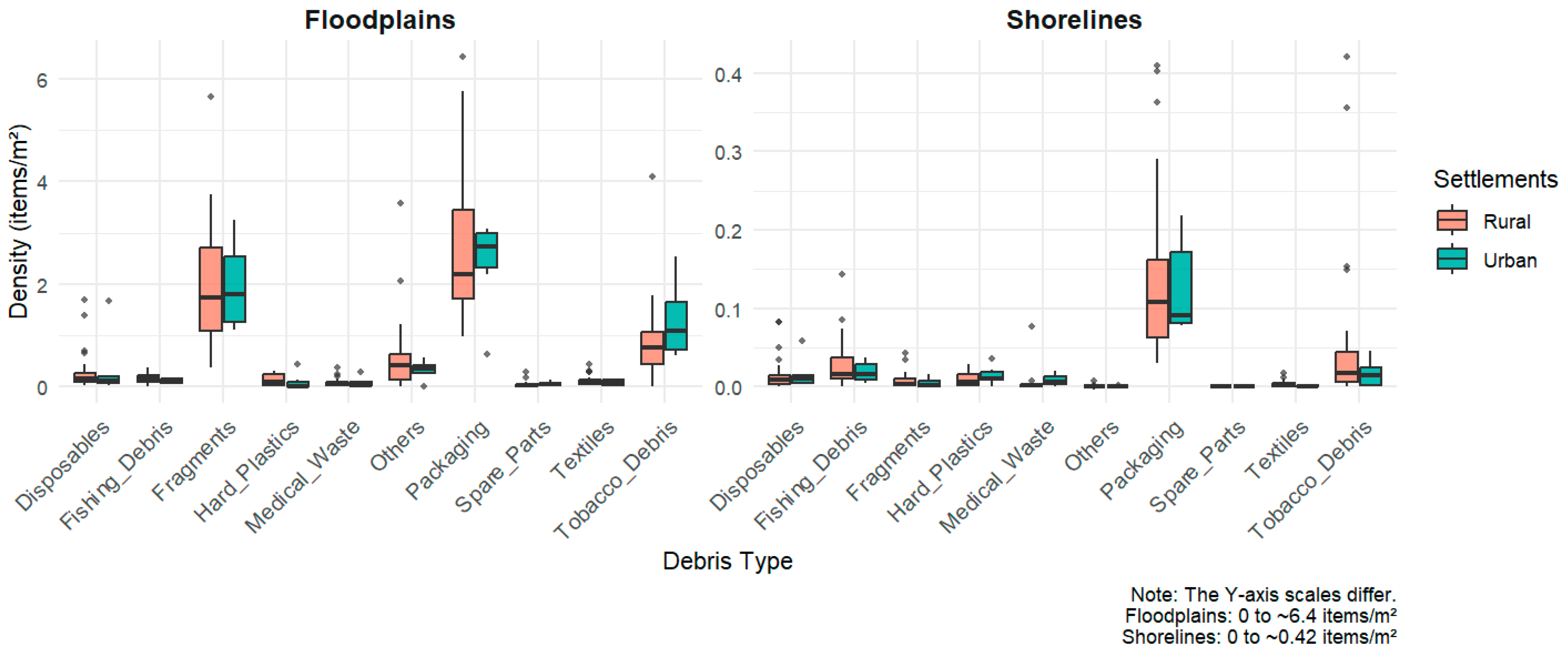
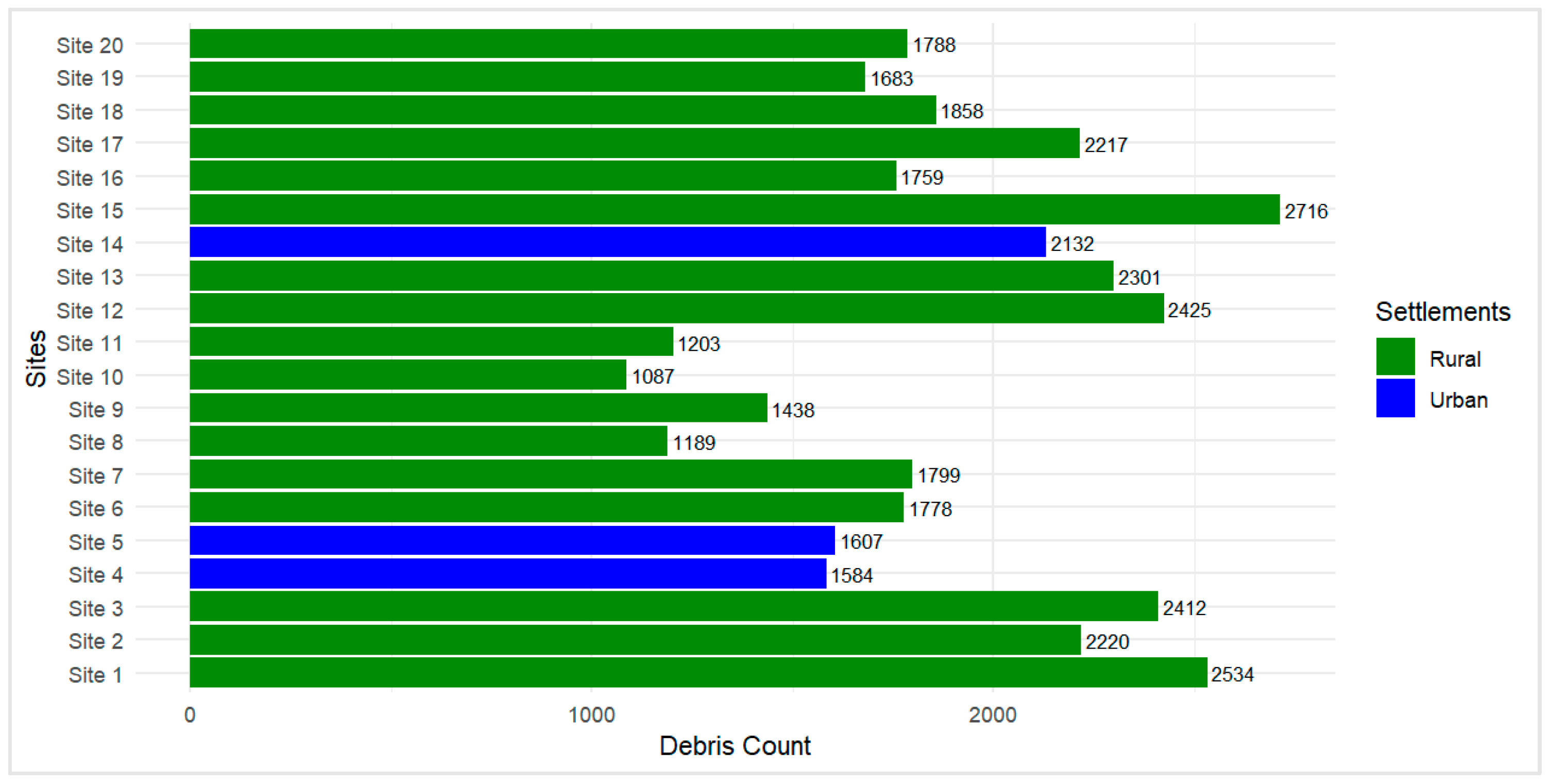

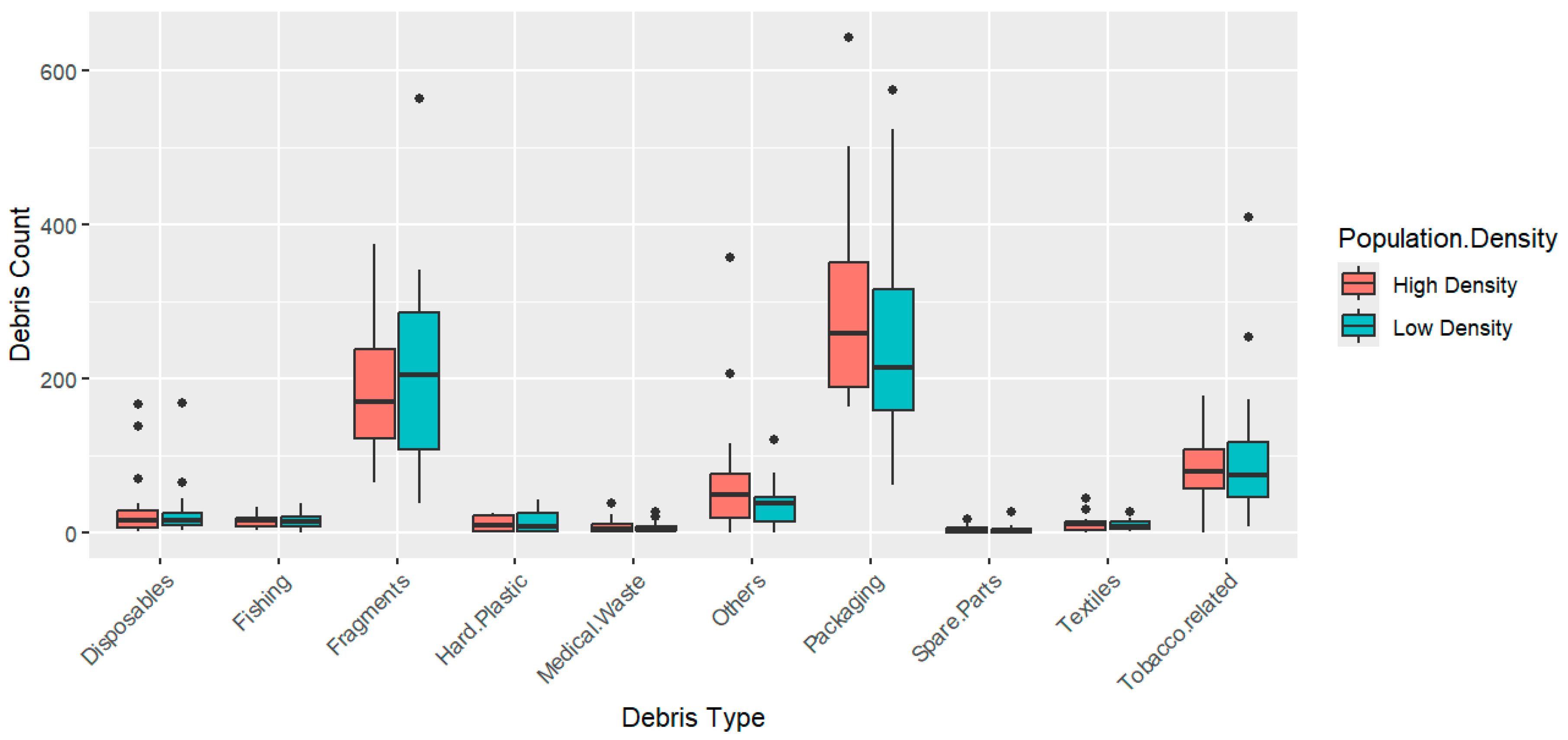
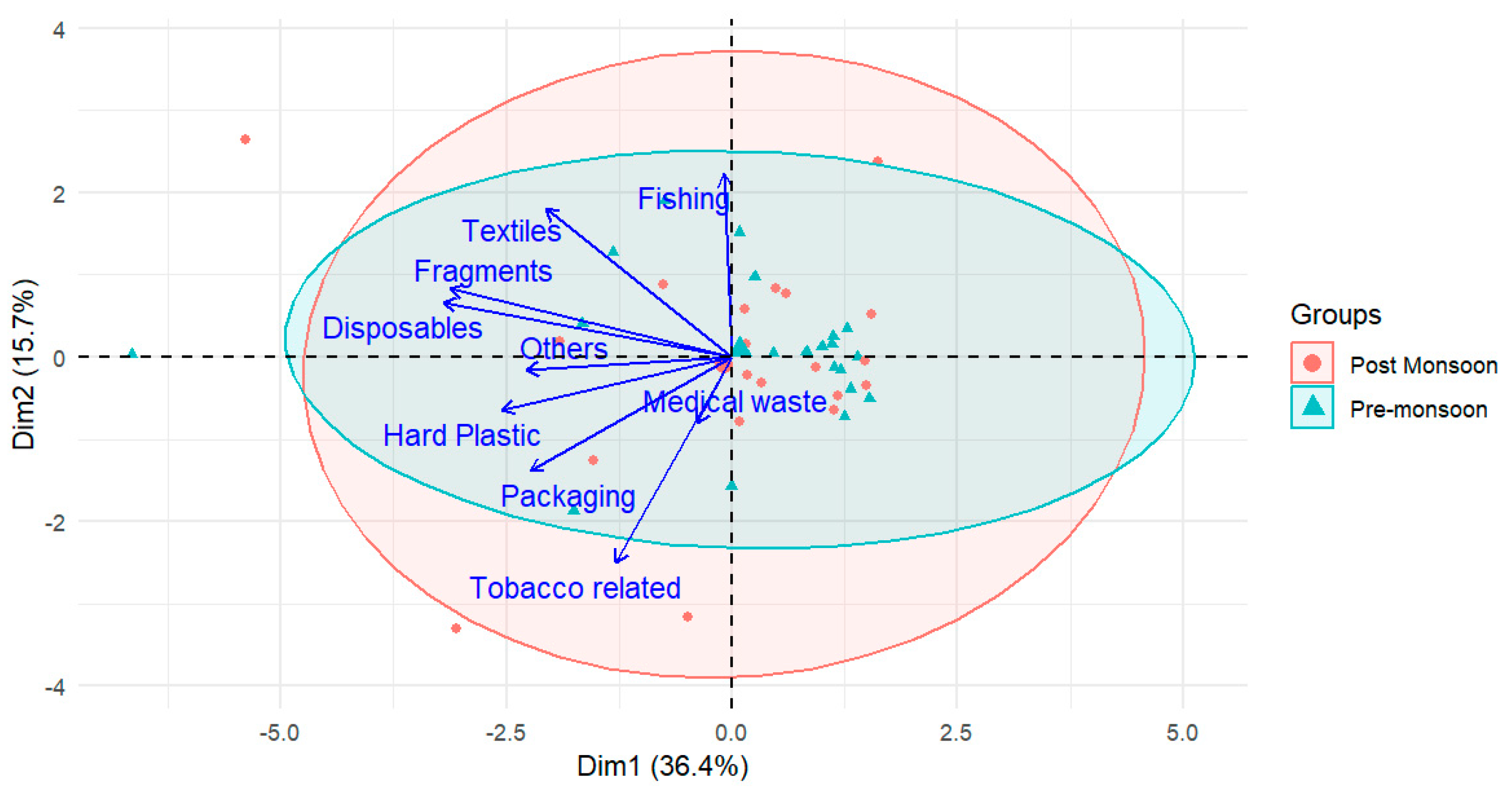
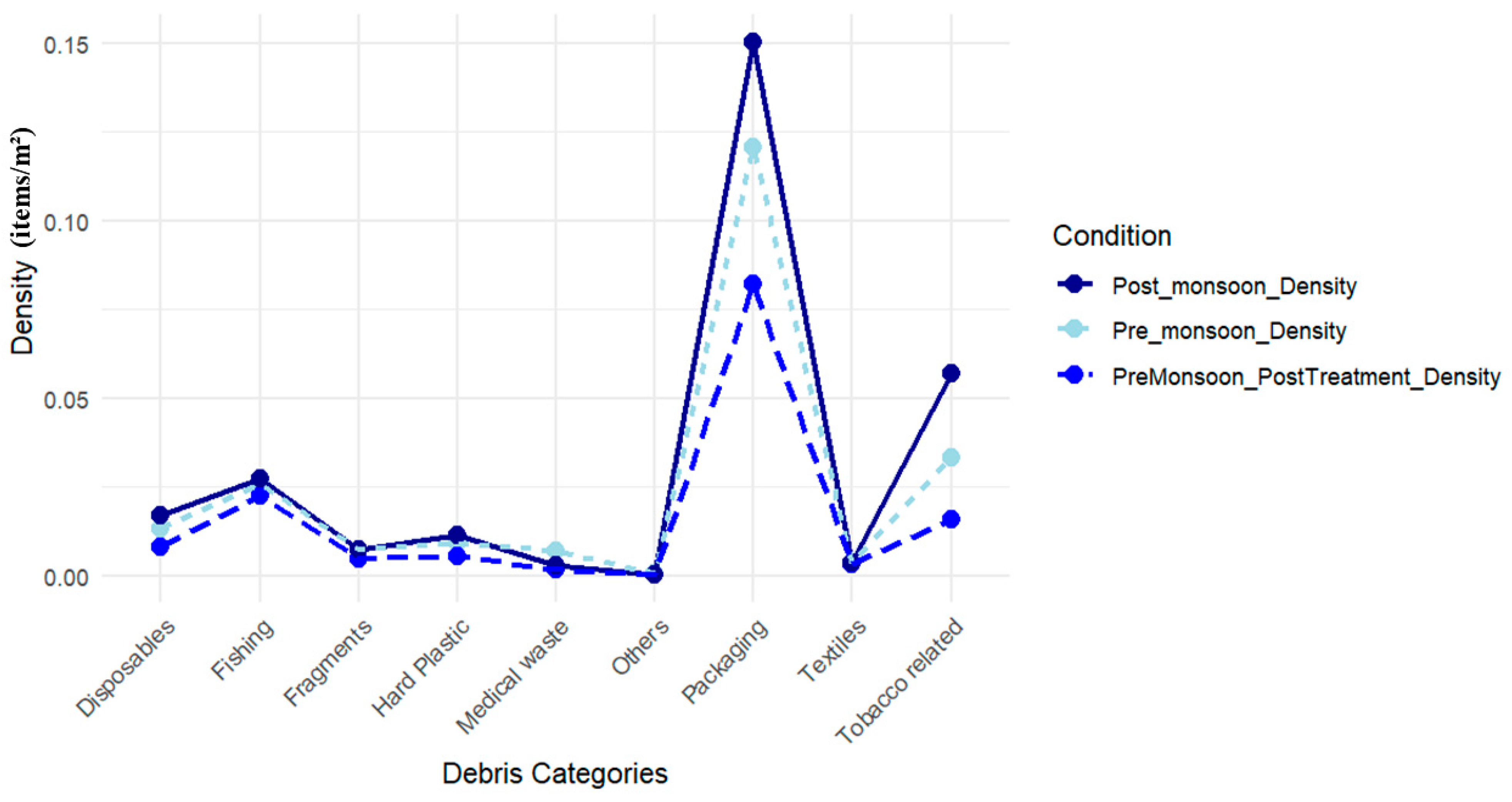
| S. No. | Category | Debris Count Recorded in High-Biodiversity Zone | Percentage of Total Category Quantities Recorded in the Study Area (%) | Mean | ±SD |
|---|---|---|---|---|---|
| 1 | Disposable cutleries | 1229 | 68.89 | 0.04 | 0.030 |
| 2 | Fishing | 819 | 72.93 | 0.03 | 0.022 |
| 3 | Fragments | 5468 | 61.97 | 0.19 | 0.087 |
| 4 | Hard Plastic | 583 | 64.85 | 0.02 | 0.008 |
| 5 | Medical Plastic Waste | 337 | 69.48 | 0.01 | 0.011 |
| 6 | Other | 1284 | 59.58 | 0.05 | 0.026 |
| 7 | Packaging | 12,484 | 63.07 | 0.44 | 0.127 |
| 8 | Spare Parts | 130 | 71.82 | 0.005 | 0.004 |
| 9 | Textile | 370 | 63.03 | 0.01 | 0.005 |
| 10 | Tobacco-Related Debris | 471 | 24.82 | 0.02 | 0.010 |
| S.No. | Measure to Be Taken | Target Area | Timescale 2 | Urgency ¹ |
|---|---|---|---|---|
| 1 | Strengthening Waste Management Infrastructure | |||
| (a) | Establish and maintain regular waste collection facilities and segregation centres in rural floodplain communities to prevent dumping and plastic discharge into riverine systems. | Rural | C | 1 |
| (b) | Upgrade waste segregation, collection, and recycling facilities to minimise landfill dependency and promotion of enhance circular economy based mechanisms. | Urban | C | 1 |
| (c) | Implement community-led waste retrieval programmes in floodplain settlements to remove accumulated plastic debris before monsoon flooding. | Rural | A | 1 |
| (d) | Develop smart waste-tracking systems (e.g., GIS, remote sensing) to identify leakage hotspots and optimise interventions. | Rural and Urban | B | 2 |
| 2 | Policy Implementation and Governance | |||
| (a) | Strengthen Extended Producer Responsibility (EPR) frameworks to hold producers accountable for plastic waste and incentivise eco-friendly packaging. | Rural and Urban | A | 1 |
| (b) | Introduce plastic taxation and incentive-based recycling schemes to encourage businesses and consumers to adopt sustainable alternatives. | Urban | B | 2 |
| (c) | Integrate plastic waste management regulations into broader rural development and urban planning policies for long-term sustainability. | Rural and Urban | B | 2 |
| (d) | Strengthen local institutions such as village councils by capacity building and resource provision | Rural | B | 1 |
| 3 | Community Engagement and Awareness | |||
| (a) | Launch localised awareness campaigns emphasising the impacts of plastic pollution on climate, marine, and freshwater ecosystems, encouraging responsible disposal. | Rural and Urban | A | 1 |
| (b) | Establish financial incentives for community-driven collection/recycling efforts, fostering local entrepreneurship in sustainable waste solutions. | Rural and Urban | B | 2 |
| (c) | Develop educational programmes (schools, NGOs) to instil long-term environmental stewardship and responsible consumption habits. | Rural and Urban | B | 2 |
| 4 | Advancing Research and Innovation | |||
| (a) | Conduct longitudinal studies on macro-, meso-, and microplastic contamination to assess climate resilience, freshwater ecosystem health, and human impacts. | Rural and Urban | B | 2 |
| (b) | Promote biodegradable packaging R&D (industry–academia collaboration) to replace single-use plastics and reduce non-recyclable waste. | Urban | B | 2 |
| (c) | Enhance scientific monitoring of plastic transport using advanced hydrological and geospatial models to inform adaptive management. | Rural and Urban | B | 2 |
Disclaimer/Publisher’s Note: The statements, opinions and data contained in all publications are solely those of the individual author(s) and contributor(s) and not of MDPI and/or the editor(s). MDPI and/or the editor(s) disclaim responsibility for any injury to people or property resulting from any ideas, methods, instructions or products referred to in the content. |
© 2025 by the authors. Licensee MDPI, Basel, Switzerland. This article is an open access article distributed under the terms and conditions of the Creative Commons Attribution (CC BY) license (https://creativecommons.org/licenses/by/4.0/).
Share and Cite
Sharma, E.; Ramachandran, A.; Dobriyal, P.; Badola, S.; Koldewey, H.; Hussain, S.A.; Badola, R. Mapping the Distribution and Discharge of Plastic Pollution in the Ganga River. Sustainability 2025, 17, 4932. https://doi.org/10.3390/su17114932
Sharma E, Ramachandran A, Dobriyal P, Badola S, Koldewey H, Hussain SA, Badola R. Mapping the Distribution and Discharge of Plastic Pollution in the Ganga River. Sustainability. 2025; 17(11):4932. https://doi.org/10.3390/su17114932
Chicago/Turabian StyleSharma, Ekta, Aishwarya Ramachandran, Pariva Dobriyal, Srishti Badola, Heather Koldewey, Syed Ainul Hussain, and Ruchi Badola. 2025. "Mapping the Distribution and Discharge of Plastic Pollution in the Ganga River" Sustainability 17, no. 11: 4932. https://doi.org/10.3390/su17114932
APA StyleSharma, E., Ramachandran, A., Dobriyal, P., Badola, S., Koldewey, H., Hussain, S. A., & Badola, R. (2025). Mapping the Distribution and Discharge of Plastic Pollution in the Ganga River. Sustainability, 17(11), 4932. https://doi.org/10.3390/su17114932






